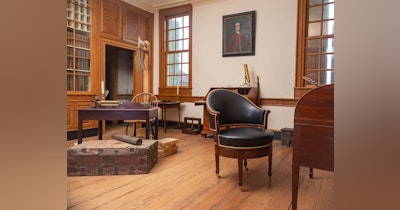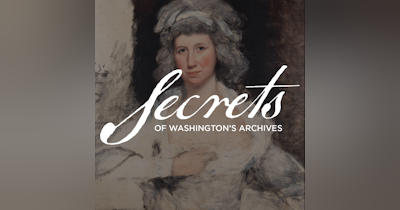Within the vault at the George Washington Presidential Library, there is a single shelf dedicated to books Martha Washington owned. This collection seems small compared to George’s library, and minuscule compared to the many books (physical or digital) a woman might own today. However, for her time and context, Martha’s collection was actually much larger than it seems.
In the late eighteenth century, the only kind of books most people had were “cheap print, invariably sold unbound or with blue-gray paper covers.”[i] These were mostly educational or religious, rather than novels like Children of the Abbey. In post-revolutionary Virginia, most rural probate inventories either did not include books or included only the Bible or other religious writing.[ii] Martha’s collection was much broader, including novels, medical texts, songbooks, and more—some of which are now at Mount Vernon, where others are at the Library of Congress or other institutions.
Novel reading was common for women of Martha’s class and in urban centers but less available to most rural Virginians. Even though white male literacy rates were high, women’s literacy was still limited.[iii] However, there were plenty of opportunities for people to listen to books read aloud, regardless of their reading ability. Families throughout the English-speaking world often included Bible reading aloud as part of their routine, but communal reading was not restricted to religious instruction.[iv] It was also a way to have fun and to liven up otherwise boring tasks.[v]
Scottish poet and physician John Armstrong contended that reading aloud was good for people’s health, because it improved strength in the chest and drove blood throughout the body.[vi] Specifically, he recommended alternating between sitting and standing for best results.[vii] He contrasted healthy reading aloud with unhealthy reading alone, which led scholars to be “’o’erwhelm’d with phlegm’ and become ‘in a dropsy drown’d.”[viii] To Martha, continually concerned with the health of her family, reading aloud may have been not just a bonding activity but also a form of exercise.
Elocution manuals were written to teach how to read aloud properly, both in small groups and more publicly. English author John Walker instructed his readers that someone reading to a small group, as Martha or Nelly may have read to the family, should stand with the book in their left hand, leaving their right hand free to gesture. They should also make eye contact with the audience as much as possible rather than keeping their eyes on the work.[ix] Martha may have learned technique from works like this, or may have learned by watching others.
Books like Walker’s have faded from our bookshelves. We now have access to professionally recorded audiobooks, reducing our reliance on family members if we don’t want to read ourselves. However, the prevalence of book clubs for children and adults shows that the desire to share our reading with the ones we love hasn’t ended.
There are also similarities in the subject matter we enjoy. Children of the Abbey, one of Martha Washington’s favorite novels and the subject of this week’s Secrets of Washington’s Archives episode, is in the Gothic genre, which might not sound familiar. However, the themes echo what we might find in thrillers at our local library or true crime podcasts online. Martha Washington’s library doesn’t look like ours, but it’s not that different, either.
Notes
[i]Amory and Hall, 391.
[ii]Amory and Hall, 388.
[iii]Lynch.
[iv]Owens, 301-304.
[v]Owens, 307; Brewster, 305.
[vi]Chambers and Thomson, 74-75; Brewster, 128-129.
[vii]Brewster, 129.
[viii]Brewster, 129-130.
[ix]Walker, vol II, 266-267, qtd. In Mullini, 2018.
References
Amory, Hugh, and David D. Hall, eds. 2007. “Practices of Reading.” In A History of the Book in America, 1:377–410. University of North Carolina Press.
Brewster, Ellen B. 2020. “Reading Aloud? Elocution Manuals and Reading Practices (1750-1800).” Oxford: Exeter College.
Chambers, Robert, and Thomas Napier Thomson, eds. 1857. “Armstrong, John, M.D.” In A Biographical Dictionary of Eminent Scotsmen. Vol. 1. Glasgow: Blackie and Son.
Lynch, Jack. 2011. “‘Every Man Able to Read.’” Colonial Williamsburg Journal. https://research.colonialwilliamsburg.org/Foundation/journal/Winter11/literacy.cfm.
Mullini, Roberta. 2018. “Reading Aloud in Britain in the Second Half of the Eighteenth Century: Theories and Beyond.” Journal of Early Modern Studies 7, no. March (March): 157-176 Pages. https://doi.org/10.13128/JEMS-2279-7149-22842.
Owens, W R. 2020. “Reading Aloud, Past and Present.” In The Edinburgh History of Reading: Early Readers, edited by Mary Hammond, 297–314. Edinburgh University Press.
















